DC Comics novels--Batman Read online
Contents
Cover
Also Available from Titan Books
Title Page
Copyright
Dedication
Prologue
1
2
3
4
5
6
7
8
9
10
11
12
13
14
15
16
17
18
19
20
21
22
23
24
25
26
27
28
29
30
31
32
33
34
35
36
37
38
39
40
Acknowledgments
About the Author
BATMAN
ALSO AVAILABLE FROM TITAN BOOKS
BATMAN: THE KILLING JOKE by Christa Faust and Gary Phillips
HARLEY QUINN: MAD LOVE by Paul Dini and Pat Cadigan
BATMAN
AN ORIGINAL NOVEL BY GREG COX
Batman created by Bob Kane with Bill Finger
TITAN BOOKS
BATMAN: THE COURT OF OWLS
Hardback ISBN: 9781785658167
Ebook ISBN: 9781785658174
Published by Titan Books
A division of Titan Publishing Group Ltd
144 Southwark Street, London SE1 0UP
www.titanbooks.com
First edition: February 2019
10 9 8 7 6 5 4 3 2 1
This is a work of fiction. Names, characters, places, and incidents either are the product of the author’s imagination or are used fictitiously, and any resemblance to actual persons, living or dead, business establishments, events, or locales is entirely coincidental. The publisher does not have any control over and does not assume any responsibility for author or third-party websites or their content.
Copyright © 2019 DC Comics.
BATMAN and all related characters and elements © & ™ DC Comics.
WB SHIELD: ™ & © Warner Bros. Entertainment Inc. (s19)
TIBO41795
No part of this publication may be reproduced, stored in a retrieval system, or transmitted, in any form or by any means without the prior written permission of the publisher, nor be otherwise circulated in any form of binding or cover other than that in which it is published and without a similar condition being imposed on the subsequent purchaser.
A CIP catalogue record for this title is available from the British Library.
Designed by Crow Books.
In memory of Audrey Munson and Evelyn Nesbit
PROLOGUE
Publish or perish.
That harsh imperative brought Professor Herbert Morse back to his book-lined office at Gotham University. After a long day of lectures and meetings, and a quick supper at a campus salad bar, he was hoping to get some serious work done on his upcoming article for the International Journal of Art History Studies.
It was, he reflected wryly, one of the paradoxes of his profession that the day-to-day business of teaching often got in the way of serious scholarship. He sighed as he flicked on the lights and shut the office door behind him to guarantee his privacy, even though it was unlikely that anyone would disturb him at this hour.
“Don’t move, Professor,” an icy voice whispered behind him. “Don’t say a word.”
Morse froze. All thought of academic pursuits fled his brain, replaced by sheer primal terror. Whatever gray matter remained capable of rational thought raced through various alarming scenarios. A disgruntled student, out to settle a score? A burglar, surprised in the act? The latter struck Morse as unlikely, given the contents of his office—which consisted mostly of books, journals, papers, a beaten-up old desk, and an overworked laptop badly in need of an upgrade.
His office wasn’t worth burgling.
Yet this was Gotham, so anything was possible: killer clowns, man-bats, clayfaces, mobsters, serial killers, masked vigilantes. For a moment, Morse allowed himself to hope that it was Batman standing behind him, wanting to question him for some bizarre reason.
I’m no criminal, Morse thought. Batman poses no danger to me.
Does he?
“Turn around,” the voice ordered.
Morse did as instructed. His heart sank as he spied the ominous figure standing between him and the door.
It wasn’t Batman.
Black body armor protected the tall, imposing intruder, while an equally dark hood concealed his features. Metal-rimmed goggles with wide, circular lenses and a jagged beak for a nose gave the stranger an eerie, owl-like visage, but even more disturbing was the way he was armed to the hilt. A black-leather bandolier slung diagonally across his chest held at least a half-dozen gleaming metal throwing knives, and another blade was sheathed at his hip. Two scabbards crossed each other atop his back, forming an X with the hilts of twin swords visible above his shoulders. Steel gauntlets ended in threatening steel claws that resembled the talons of a predatory bird.
Who? Morse wondered. He didn’t recognize the intruder from the nightly news or the city papers. Like many Gothamites, he preferred not to dwell on the various homicidal maniacs who seemed to escape from Arkham Asylum on a regular basis, but one couldn’t live in Gotham for as long as Morse had without acquiring a working knowledge of the city’s most infamous public menaces. Morse could tell the Joker from the Riddler—although he’d been lucky enough to keep that knowledge, well, academic up until the present.
He had no idea who this particular costumed grotesque was, or what he wanted. Just that the armed stranger radiated menace.
“Sit,” the intruder said, indicating the chair that faced the desk.
Instantly Morse dropped into the chair, which was customarily occupied by his visitors during office hours.
Sitting in the wrong chair only added to his unease, as though his own sanctuary no longer belonged to him. He contemplated the looming stranger, and began to tremble. His mouth felt as dry as a dusty Grecian urn. His limbs were rubbery. He was acutely aware of just how empty the building was at this time of night and yet how unlikely it was that campus security would take note of his office lights burning after hours.
“Please,” he whimpered. “Just tell me what you want.”
“Answers.” The avian mask concealed the man’s expression, but not his sardonic tone. “We’re going to have a conversation… about art and history.”
Morse blinked in surprise. “This is about my work?”
A dry chuckle escaped the mask.
“Your work? Not exactly.”
Morse didn’t understand. The intruder’s cryptic responses scraped away at what was left of his nerves.
“Please, no games.” Tears streaked the professor’s cheeks. A framed photo of his family, resting on his desk, reminded Morse just how much he had to lose. “Ask me anything. I’ll tell you whatever you want to know.”
“Yes, you will.” The intruder drew one of the knives from his bandolier. “Eventually.”
“You can come in now,” Commissioner James Gordon said to the seemingly empty office. “The coast is clear.”
Batman entered the professor’s office through an open fourth-story window. His matte-black suit, cape, and cowl blended with the night outside, much as the winged sigil emblazoned on his chest matched the Bat-Signal currently shining above Gotham, summoning him from his nightly patrol. A soaked carpet squelched beneath his boots as he joined Gordon in the office
—which appeared to be a crime scene, as well. He scanned the room.
A fluorescent light flickered overhead.
The charred remains of what was presumably Professor Herbert Morse slumped in a fire-damaged wooden chair facing his desk. The ceiling was blackened directly above the corpse, while scorch marks spread outward from the body. The building’s sprinkler system had drenched the room, leaving water pooling on every surface. Any lingering smoke had dispersed, but a disturbing odor hung in the air.
Batman scowled. The smell of burnt human flesh was, unfortunately, all too familiar to him.
“The fire department completed their preliminary inspection and pronounced the scene safe to enter,” Gordon said. His rumpled trench coat was buckled against the brisk autumn breeze blowing in through the window. His weathered features bore a stoic expression. A pair of glasses reflected the overhead lights as he took in the grisly tableau. Like Batman, the veteran cop had seen more than his share of horrors. “I have a full forensics team waiting for me to give them the green light, but I assumed you’d want to look things over first.” He glanced at his wristwatch. “I can give you ten minutes, more if absolutely necessary.”
“Thanks,” Batman replied. “I came as soon as I saw the signal.” He had been patrolling the Narrows when he’d spotted the beacon in the sky. A quick scan of police communications had let him know where to find Gordon.
Surveying the office, he regretted that the firefighters had intruded upon the scene before he could examine it thoroughly, but he understood the protocol. The fire marshal had to verify that the flames were out and deem the premises structurally secure before the GCPD could get to work. At least the sprinklers had been turned off, Batman noted—hopefully before the spray washed away too much valuable evidence.
He tilted his head back to inspect the blackened portion of the ceiling directly above the dead man’s head. The sprinklers had put out the blaze before it could spread too far from the burning body.
Completing his initial scan of the office, he turned his full attention to the body in the chair. The head appeared more badly burned than the rest of the body, leaving the face a blackened ruin so that the victim’s features resisted easy identification. Dental records likely would be required to confirm that the dead man was indeed Herbert Morse.
“He wasn’t caught in the fire,” Batman said. “The fire started with him.”
Gordon nodded in agreement. “That’s why I fired up the Signal. This was no accident.”
Leaning in, Batman sniffed the remains. “No obvious smell of accelerant.” Pulling a portable vapor trace analyzer from his belt, he confirmed that no suspicious fumes lingered in the air. Melted glass on the man’s wristwatch indicated that the fire had reached a temperature of at least 1,500 degrees Fahrenheit. Not enough to reduce the body to ash in the time that had elapsed, but hot enough to burn off most of the victim’s clothing and blacken the remains from head to toe.
What could cause the fire to burn so hot and so fast? he wondered. And…
“The question is,” Gordon said, “was he dead before or after he was set on fire?” The detective contemplated the corpse while keeping out of Batman’s way. “Can’t imagine he’d just sit still while he was burning alive.”
“Unless he was restrained.” Batman inspected the dead man’s hands and wrists, which were still resting on the chair’s armrests. Ordinarily a burning body would curl into a fetal position as the cooked muscles contracted, so the fact that Morse remained seated in his chair merited a closer look. A low grunt escaped Batman’s lips as he made a gruesome discovery, which the charred flesh had obscured until now. He crouched lower to examine the man’s feet, then straightened again.
“Look here, Jim,” he said, pointing. “Morse’s hands were nailed to the chair and his feet were nailed to the legs. He wasn’t going anywhere, no matter how much pain he was in.”
“Good Lord,” Gordon said, shaking his head. He came forward to see the charred nail heads. They were driven deep into the tops of Morse’s bare hands and what was left of his shoes. Fragments of burnt flesh made them difficult to spot. “The poor bastard. That’s an ugly way to go, even by Gotham standards.”
“Yes,” Batman agreed. He studied the surface of the wooden chair, noting that it had blistered in a pattern resembling alligator scales—another indicator of the extreme heat coming from the burning body. It would take an autopsy to tell for certain whether Morse had died before or after going up in flames, but Batman feared that the professor had suffered badly either way.
Closer inspection revealed what appeared to be dozens of small incisions and puncture wounds in the carbonized epidermis, indicating that the victim had been stabbed repeatedly before burning. It was difficult to determine without a full medical examination, but Batman estimated that there were at least fifty such wounds. Despite that fact, there was no indication that blood had sprayed in the area around the victim.
“From what I can tell, Morse was tortured first, then set ablaze.”
“Jesus,” Gordon murmured. “Who would do that—and to a college professor, of all people?”
Good question, Batman thought. There was something about the killing that bothered him for reasons beyond the obvious. Something both familiar and troubling. More than fifty knife wounds…
“The door was locked from the inside,” Gordon said. “The firefighters had to break it down to gain access.”
Batman moved to the entrance. The splintered remains of the door were propped up against the frame. Continuing a circuit of the room, he began a more focused examination of the surroundings. Waterlogged books and papers rested atop the professor’s desk, too heavy to be blown about by the breeze coming in through the window.
“Was the window open when the firefighters arrived?” Batman asked.
Gordon consulted his notepad. “I believe so. Why?”
“Maybe I’m not the only one who preferred the window to the door.” He crossed to the sill and activated the UV lenses in his cowl. They detected minute traces of blood on the outside of the window. Heedless of the drop, he climbed out onto the ledge and scanned the red-brick exterior. Additional splotches of blood— most likely belonging to Morse—could be spotted between the top of the window and the roof. Batman also spied what appeared to be fresh gouges in the brickwork, as though somebody had clawed their way up the side of the building after dealing with Morse. Somebody with blood on their hands.
Or claws.
“Morse’s visitor left this way,” Batman said, rejoining Gordon in the office. “Escaping via the roof, probably while Morse was still burning.”
“But after he was tortured,” Gordon said.
Batman nodded, and a theory began to take shape. Morse had been stabbed repeatedly by somebody who knew what they were doing, and the lack of blood splatter suggested that the assailant had carefully avoided any major arteries while torturing— interrogating?—Morse. The fire was new, but Batman had seen this technique before. Indeed, his own great-great-grandfather had endured a very similar ordeal, nearly a century ago…
Careful, he warned himself. Don’t jump to conclusions.
“What is it?” Gordon asked.
“Too soon to say,” Batman said. But I hope to God I’m wrong. The key lay in determining the killer’s motive. Had Morse been tortured for information?
Stepping over to the desk, Batman conducted a quick sweep of Morse’s papers and files. The soaked documents on the desk seemed innocuous enough: print-outs of administrative memos and announcements, class calendars, lesson plans, and such. Inked notes bled onto a soggy yellow legal pad, but held nothing that would warrant burning someone alive. The contents of the desk drawers were unremarkable, as well, and there weren’t any conspicuous gaps in Morse’s library, which held the sort of volumes appropriate to an art historian’s bookshelves.
One thing was missing, however.
There was a printer, but no computer in sight. Nor was there the distinctive smel
l of burnt circuitry.
“Did Morse have a laptop?” he asked.
Gordon checked his notes again. “Nothing reported found by the firefighters. You think the intruder made off with it?”
“Possibly.” If Morse had planned to work late, he would have needed something on which to do so.
A row of low wooden file cabinets lined an interior wall. Each drawer had a lock on it, but they pulled open easily enough, exposing hanging files crammed with overstuffed folders. Switching the lenses in his cowl to magnify, Batman knelt to examine the locks. Almost invisible scratch marks indicated that the locks might have been picked by an expert looking for… what?
Most of the drawers were crammed to capacity, but one of them showed some extra space between two hanging files, as though a folder or two had gone missing. Leafing through the surrounding files, Batman quickly determined that they contained work by and evaluations of various graduate students being mentored by Morse. The files were in alphabetical order by the students’ names.
The gap occurred somewhere between “K” and “N.”
“Find anything?” Gordon peered over his shoulder.
“I can’t be sure, but it looks as if the intruder may have rifled through Morse’s student files—and absconded with some of them.”
“You think this might have something to do with one of his students?”
“I’m not ruling anything out,” Batman replied. “But the torture, the missing laptop, the files… everything indicates that the intruder was after information.”
“From an art history professor?” Gordon scratched his head. “I still don’t get it.”
Gordon’s confusion was well-founded. Although no place in Gotham was truly safe from crime, the university wasn’t one of Batman’s usual hunting grounds. The science labs occasionally attracted burglars intent on taking valuable equipment, but in his experience there had never before been a murder in the Arts Buildings. Academia was seldom cutthroat enough to warrant his attention.
What had Morse known—or been suspected to know—that had cost him his life? Batman made a mental note to thoroughly review Morse’s publications, classes, syllabi, and curriculums. The more he knew about the professor’s work, the more likely he could deduce why Morse had been targeted.

 Q-Space
Q-Space Godzilla - the Official Movie Novelization
Godzilla - the Official Movie Novelization War for the Planet of the Apes: Official Movie Novelization
War for the Planet of the Apes: Official Movie Novelization Underworld: Evolution
Underworld: Evolution Underworld
Underworld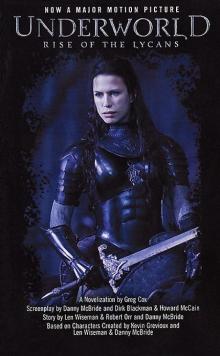 Rise of the Lycans
Rise of the Lycans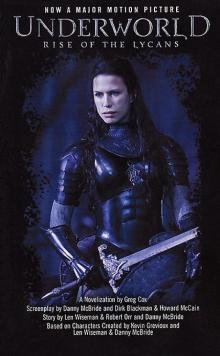 04 - Rise of the Lycans
04 - Rise of the Lycans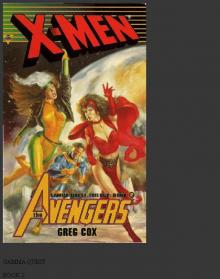 X-Men and the Avengers: Search and Rescue
X-Men and the Avengers: Search and Rescue Child of Two Worlds
Child of Two Worlds Welcome to Promise City
Welcome to Promise City The Librarians and the Mother Goose Chase
The Librarians and the Mother Goose Chase Dragon's Honor
Dragon's Honor 03 - Evolution
03 - Evolution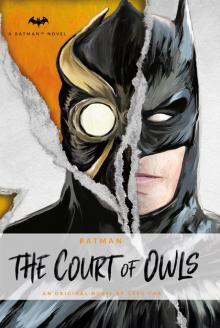 DC Comics novels--Batman
DC Comics novels--Batman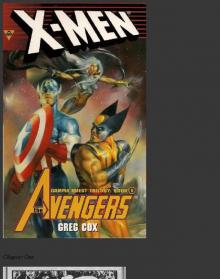 X-Men and the Avengers: Lost and Found
X-Men and the Avengers: Lost and Found Foul Deeds Will Rise
Foul Deeds Will Rise 02 - Blood Enemy
02 - Blood Enemy Terminator Salvation: Cold War
Terminator Salvation: Cold War The Weight of Worlds
The Weight of Worlds The Antares Maelstrom
The Antares Maelstrom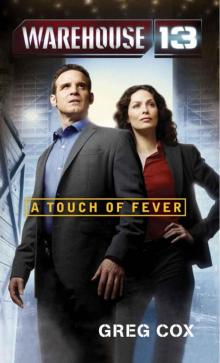 Warehouse 13: A Touch of Fever
Warehouse 13: A Touch of Fever Underworld: Blood Enemy
Underworld: Blood Enemy The Rise and Fall of Khan Noonien Singh
The Rise and Fall of Khan Noonien Singh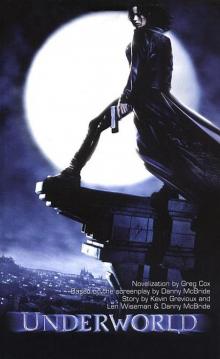 01 - Underworld
01 - Underworld The 4400- the Vesuvius Prophecy
The 4400- the Vesuvius Prophecy Assignment: Eternity
Assignment: Eternity The Eugenics Wars, Vol. 2: The Rise and Fall of Khan Noonien Singh
The Eugenics Wars, Vol. 2: The Rise and Fall of Khan Noonien Singh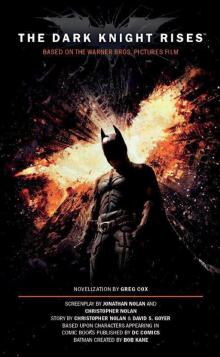 The Dark Knight Rises: The Official Novelization
The Dark Knight Rises: The Official Novelization The Bestseller Job
The Bestseller Job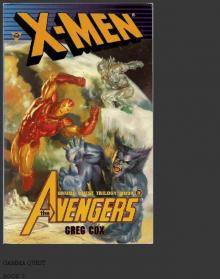 X-Men and the Avengers: Friend or Foe?
X-Men and the Avengers: Friend or Foe?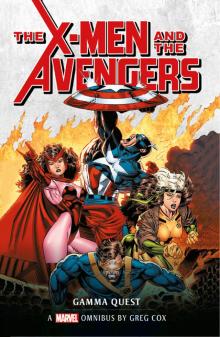 Marvel Classic Novels--X-Men and the Avengers
Marvel Classic Novels--X-Men and the Avengers STAR TREK: TOS - The Eugenics Wars, Volume Two
STAR TREK: TOS - The Eugenics Wars, Volume Two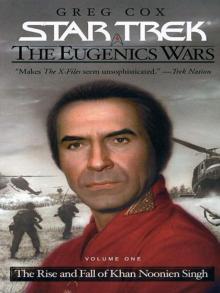 STAR TREK: TOS - The Eugenics Wars, Volume One
STAR TREK: TOS - The Eugenics Wars, Volume One The Black Shore
The Black Shore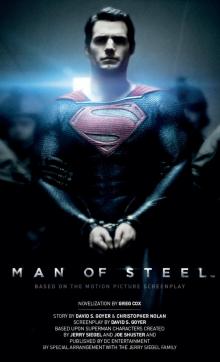 Man of Steel: The Official Movie Novelization
Man of Steel: The Official Movie Novelization Loose ends r-1
Loose ends r-1 Legacies
Legacies The Eugenics Wars, Volume Two
The Eugenics Wars, Volume Two Star Trek: The Original Series - 148 - The Weight of Worlds
Star Trek: The Original Series - 148 - The Weight of Worlds Star Trek: The Original Series: The Rings of Time
Star Trek: The Original Series: The Rings of Time Godzilla--The Official Movie Novelization
Godzilla--The Official Movie Novelization Star Trek: The Original Series - 160 - Foul Deeds Will Rise
Star Trek: The Original Series - 160 - Foul Deeds Will Rise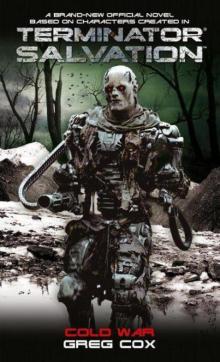 Terminator Salvation: Cold War ts-3
Terminator Salvation: Cold War ts-3 Star Trek: The Original Series: Miasma
Star Trek: The Original Series: Miasma Star Trek: The Original Series: No Time Like the Past
Star Trek: The Original Series: No Time Like the Past Child of Two Worlds (Star Trek: The Original Series)
Child of Two Worlds (Star Trek: The Original Series) THE 4400® WELCOME TO PROMISE CITY
THE 4400® WELCOME TO PROMISE CITY Star Trek: The Original Series: The Rings of Time (star trek: the original series)
Star Trek: The Original Series: The Rings of Time (star trek: the original series) To Reign in Hell: The Exile of Khan Noonien Singh
To Reign in Hell: The Exile of Khan Noonien Singh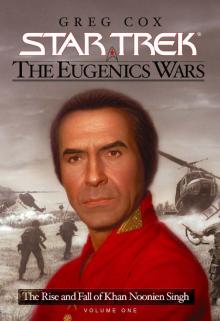 Star Trek: The Eugenics War, Vol. 1
Star Trek: The Eugenics War, Vol. 1 The Q Continuum
The Q Continuum